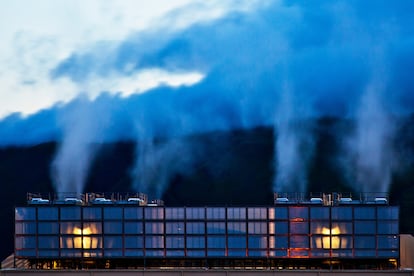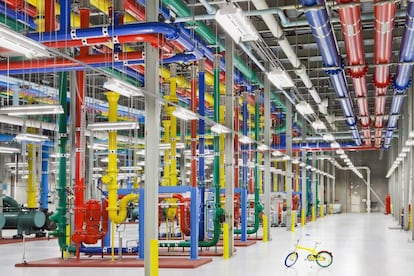Artificial intelligence guzzles billions of liters of water
The growing thirst of data centers, which use water to cool their equipment, is beginning to cause tensions in the territories where they are located

The residents of The Dalles, a small town in Oregon, are living a paradox. Although the place is at the foot of the mighty Columbia River, its climate is practically desert-like: rainfall is scarce, and two summers ago the temperature reached 118 degrees Fahrenheit. The threat of water restrictions has been hanging over the town’s 15,000 inhabitants for some time now. This is why they were not happy to learn, at the beginning of the year, that more than 25% of the total consumption of that valuable resource is going to a Google data center, which uses it to cool the thousands of computers that fill the infrastructure. According to local media outlet Oregon Live, the facility has nearly tripled its water use in the last five years, and the technology multinational plans to open two more data centers along the Columbia River. Environmentalists have already warned that this could affect the flora and fauna of the area, and even cause shortages among farmers in The Dalles.
This is not an isolated case in the United States, a country that concentrates approximately 30% of all the data centers in the world. Arizona, Utah and South Carolina are well aware of the insatiable thirst of this type of infrastructure. They are also familiar with it in the Netherlands, where Microsoft was involved in a scandal last year when news broke out that one of its facilities consumed four times more water than declared in a context of drought. Or in Germany, where Brandenburg authorities denied Google permission to build a data center in the region, as a Tesla gigafactory was already consuming too much water.
Things like streaming series, using online apps (those that are not installed on your phone) or saving photos in the cloud are possible thanks to a global infrastructure that consists of a large combination of data centers and more than a million kilometers of wiring. The growing complexity of the applications that are used every day demand more and more computing power, which translates into legions of computers running at maximum power day and night. Their energy consumption already amounts to at least 2% of the world’s total. The machines must be kept cool so they do not overheat: this can be done with ventilation systems similar to those used in personal computers, but cooling the processors with water is cheaper.
The technological thirst is on the rise. Google’s water consumption increased by 20% in 2022, according to figures provided by the company; that of Microsoft, owner of 75% of OpenAI (the creators of ChatGPT), increased by 34% in the same period. The water resources consumed in the generation of electricity that powers the servers, or that of the hardware manufacturing processes, are not taken into account here. Amazon, which along with the previous two controls almost half the hyper data centers in the world (those with more than 5,000 servers) and whose subsidiary AWS leads the cloud computing market, chose not to provide any data for this story.
The next most important company is Meta, the parent company of Facebook, Instagram, WhatsApp and Messenger, which used 2.7% more in 2022. Meta plans to open a hyper data center in Talavera de la Reina, Spain, which, as EL PAÍS reported, will consume more than 600 million liters of drinking water annually. Company sources assure that the project is still on track, advancing at the pace set by the relevant regulations, although construction has not yet begun.
How can we explain this sudden boom in water consumption by technology companies? Why is it lower for Meta or Apple than for Microsoft and Google? On November 4, 2022, ChatGPT — the chatbot that kicked off the race for generative artificial intelligence (AI) — was introduced to the world. Google already had similar large language models, such as LaMDA, in the experimental phase, but they were not available to the public, as these models must be trained before they star working. This requires legions of high-powered computers (GPUs) to process enormous amounts of data day and night for weeks or even months to find patterns in the texts that can then be used to articulate meaningful fragments. In the case of GPT-4 (the most advanced version of ChatGPT to date), that training took place in Des Moines, Iowa, something that the local residents knew nothing about until a senior Microsoft official said in a speech that it “was literally made next to cornfields west of Des Moines,” according to Associated Press.
The additional effort to develop large AI models may have skyrocketed the water consumption of Google and Microsoft, the two technology companies that have invested the most in this technology. This is what researcher Shaolei Ren, associate professor of electrical and computer engineering at the University of California, Riverside, and specialist in AI sustainability, believes. “We cannot say it with certainty if the companies don’t provide concrete data, but the increase in 2022 was quite hefty compared to 2021, and we know that at that time they invested very heavily in generative AI, as well as in other AI-related services,” he explains via email. “AI has been integrated into almost all of Microsoft and Google’s everyday products, including their search engines.”
Companies do not share data on how much extra water and energy it costs to train AI models compared to the usual consumption of data centers. “What we do know, because the director of one of these infrastructures confirmed it to me, is that the chips used in AI training consume much more than those of common servers,” points out Ana Valdivia, professor of artificial intelligence, government and policy at the Oxford Internet Institute, whose most recent research focuses on assessing the environmental impact of AI.
At the end of the year, Ren and three other colleagues will publish research in which they offer an estimated figure of how much water it costs to chat with ChatGPT. For every 5 to 50 prompts (questions or instructions), ChatGPT consumes half a liter of water. The range of 5 to 50 has to do with the complexity of the prompts. The estimate includes all the water used during the training of the model, which is the moment of greatest consumption, and that used by the machine to process the commands.
The affected companies offer other arguments. A Google spokeswoman says that the large jump in water consumption in 2022 “corresponds to business growth.” Microsoft’s response is almost verbatim.
Other large technology companies, such as Meta (2.7%) or Apple (8.5%), have also had an increase in water consumption, but significantly smaller than those of Microsoft and Google. Even though they are business giants and their activity has grown, their commitment to AI is not so big. Although this technology is present in their applications, they do not have large models similar to ChatGPT (or Google’s Bard, or Microsoft’s Copilot).
How water is consumed
Data centers resemble industrial warehouses with multiple rooms. Each of them contains rows of racks — vertical units that house IT equipment — the height of a refrigerator. These rows are arranged in aisles, so that operators can manipulate the circuits of each machine.
The servers emit heat, and the concentration of all that equipment in one place heightens this effect. Many data centers use cooling towers to prevent overheating, the same system used in other industries. It is based on exposing a flow of water to a current of air in a heat exchanger, so that the evaporation cools the circuits.

This method is more energy efficient than electric coolers, but it involves a significant amount of water evaporating (i.e. not returning to the circuit). That is the water that appears as “consumed” in the technology companies’ records, explains Ren’s study. Depending on the outdoor wet-bulb temperature, a cooling tower typically consumes between one and four liters of water (up to nine in the summer) for every kWh of server power.
Approximately 20% of the water used in cooling systems (that which does not evaporate) is discharged at the end of the cycle into wastewater treatment plants. “This water contains large amounts of minerals and salt, so it cannot be used for human consumption without being treated first,” explains Ren.
The average consumption of a data center is difficult to determine. Those in colder climates need less refrigeration; in the same way, the demand for water is different in the hottest times of the year than in the coldest ones. They do need, however, to use clean, treated water to avoid blockages and the growth of bacteria in the pipes. When sea or reclaimed water is used, it has to be purified before it is put into the cooling systems. In the case of Google, almost 90% of its consumption in the U.S. came from drinking sources, according to Ren.
Location matters
Data centers used to be in cities, but the growing energy needs of these infrastructures have pushed them out of the urban environment, which is unable to fulfill them. “They also need a safe location, one that has a stable supply of electricity and is not at risk of climate catastrophe. For all these reasons, in the last two decades they have gone to the outskirts,” explains Lorena Jaume-Palasí, founder of Algorithm Watch and The Ethical Tech Society and science and technology advisor to the European Parliament.
“Modern data centers are very extensive. They are usually located near the desert or in agricultural areas, so they’re able to expand: it is common for server modules to be set up and moved, according to needs,” she says. A study by Virginia Tech researchers estimates that one-fifth of U.S. data centers consume water from basins with moderate or high water stress, areas where solar or wind energy is usually available.
Aurora Gómez, from the Tu nube seca mi río (Your cloud dries my river) collective, which was born as a reaction to the mega center that Meta will build in Talavera de la Reina (Spain), sees a pattern behind these actions. “Companies usually look for unpopulated areas with high unemployment rates for their data centers, so that there is little social opposition,” she points out.
A problem with no prospect of solution
The industry is clearly betting on integrating AI into more and more products and services. Is there a way to train AI models without consuming large amounts of water? Ren thinks not. “Electric dryers could be used to cool the computers, but they use a lot of energy, so the water consumption involved in generating electricity would greatly increase. On paper it is possible not to use water in the process, but I think it is very difficult,” concludes the academic.
That is what the companies argue, as they immerse themselves in their plans to improve the efficiency of their systems. According to Meta sources, the new data centers that the company plans to develop especially for AI will use electric drying systems that do not require water (other than that necessary to generate electricity). According to a recent study by Javier Farfan and Alena Lohrmann, in which current consumption data and economic growth prospects are taken into account, in 2030 Europe will need more than 820 million cubic meters of water a year just so that people can use the internet.
Some voices are beginning to call for a decrease in the use of digital tools. The underlying idea is the same as with transportation or meat consumption: the only effective way to reverse the climate crisis is to lower production and consumption levels. That is what degrowth theories maintain.
Valdivia does not think that digital degrowth is the solution. “It seems to me that holding people responsible for this consumption is the wrong approach. Besides, data centers are much more useful and socially necessary than, say, electric cars. There are alternatives to mobility: you can leave the car and take the bus or the train. But there is no alternative to data centers.”
Sign up for our weekly newsletter to get more English-language news coverage from EL PAÍS USA Edition
Tu suscripción se está usando en otro dispositivo
¿Quieres añadir otro usuario a tu suscripción?
Si continúas leyendo en este dispositivo, no se podrá leer en el otro.
FlechaTu suscripción se está usando en otro dispositivo y solo puedes acceder a EL PAÍS desde un dispositivo a la vez.
Si quieres compartir tu cuenta, cambia tu suscripción a la modalidad Premium, así podrás añadir otro usuario. Cada uno accederá con su propia cuenta de email, lo que os permitirá personalizar vuestra experiencia en EL PAÍS.
¿Tienes una suscripción de empresa? Accede aquí para contratar más cuentas.
En el caso de no saber quién está usando tu cuenta, te recomendamos cambiar tu contraseña aquí.
Si decides continuar compartiendo tu cuenta, este mensaje se mostrará en tu dispositivo y en el de la otra persona que está usando tu cuenta de forma indefinida, afectando a tu experiencia de lectura. Puedes consultar aquí los términos y condiciones de la suscripción digital.
More information
Archived In
Últimas noticias
The metaverse, four years later: Is it finished or just at a standstill?
$3,000 and a plane ticket: The United States increases incentives for migrants to self-deport before the end of the year
Charles Dubouloz, mountaineering star, retires at 36 with a farewell tour inspired by Walter Bonatti
From the White House to diplomatic gifts: Lego wins over adult fans, brick by brick
Most viewed
- The low-cost creative revolution: How technology is making art accessible to everyone
- Christian Louboutin: ‘Young people don’t want to be like their parents. And if their parents wear sneakers, they’re going to look for something else’
- All the effects of gentrification in one corner of Mexico’s Colonia Roma
- Christmas loses its festive spirit: ICE fears cast shadow over religious celebrations
- Liset Menéndez de la Prida, neuroscientist: ‘It’s not normal to constantly seek pleasure; it’s important to be bored, to be calm’











































